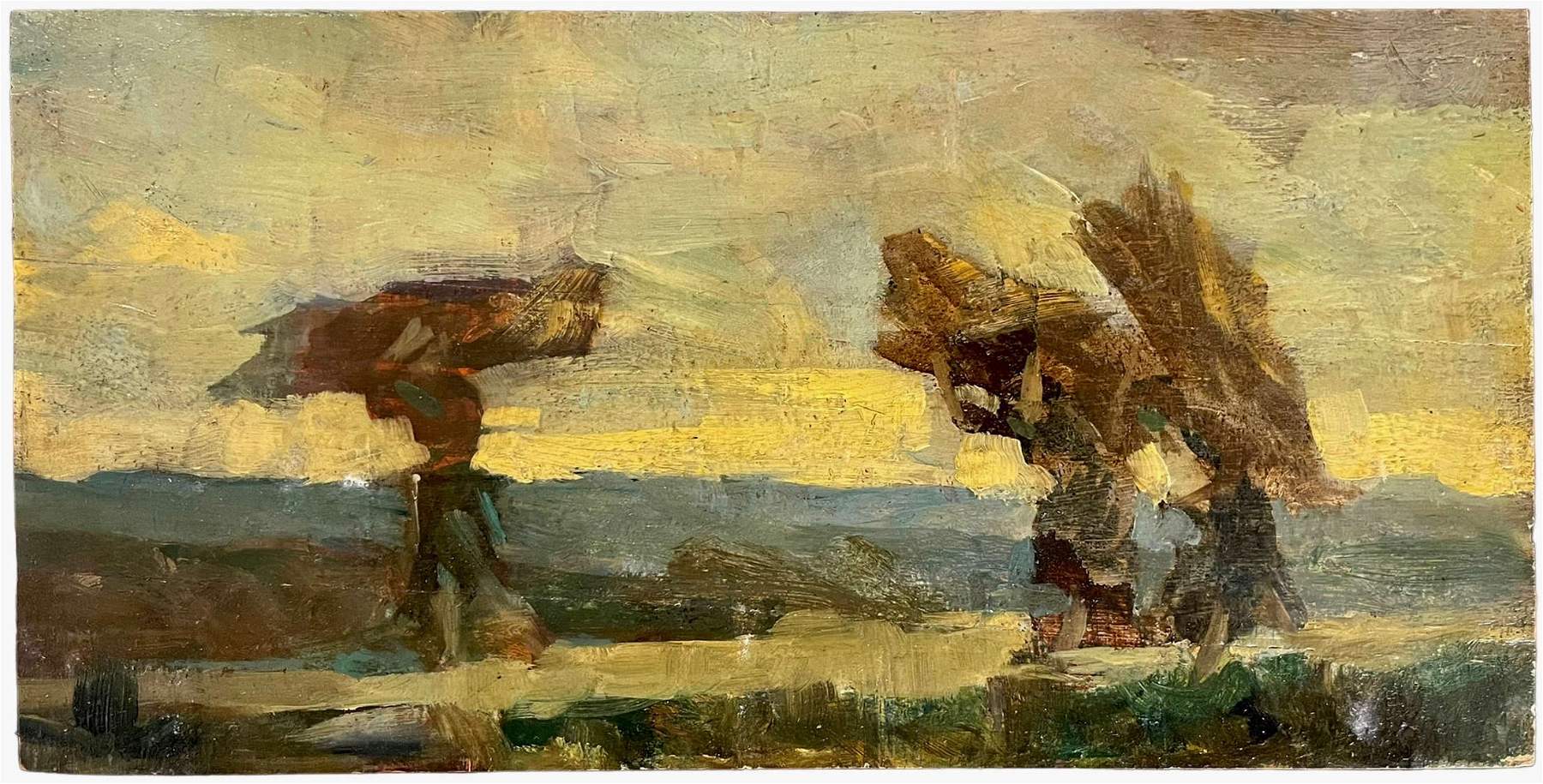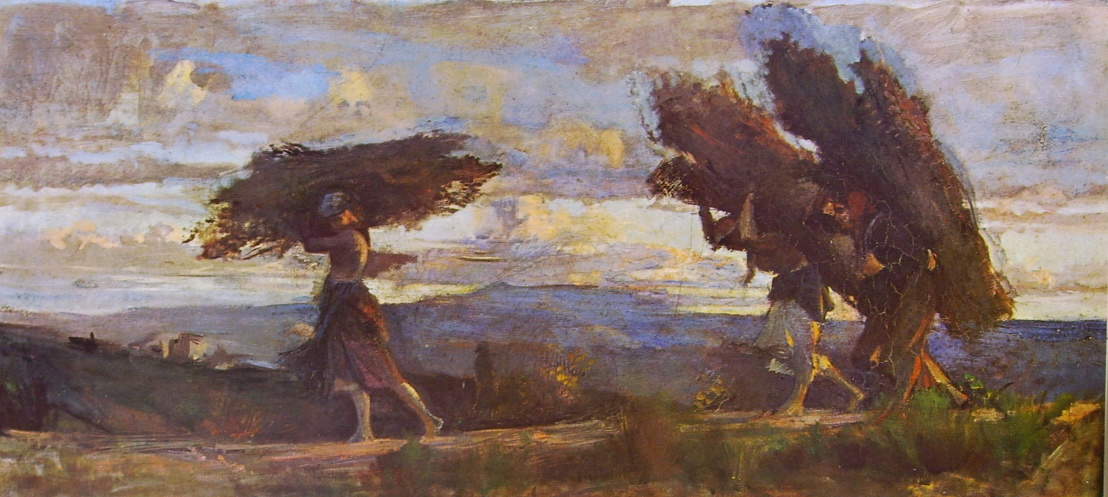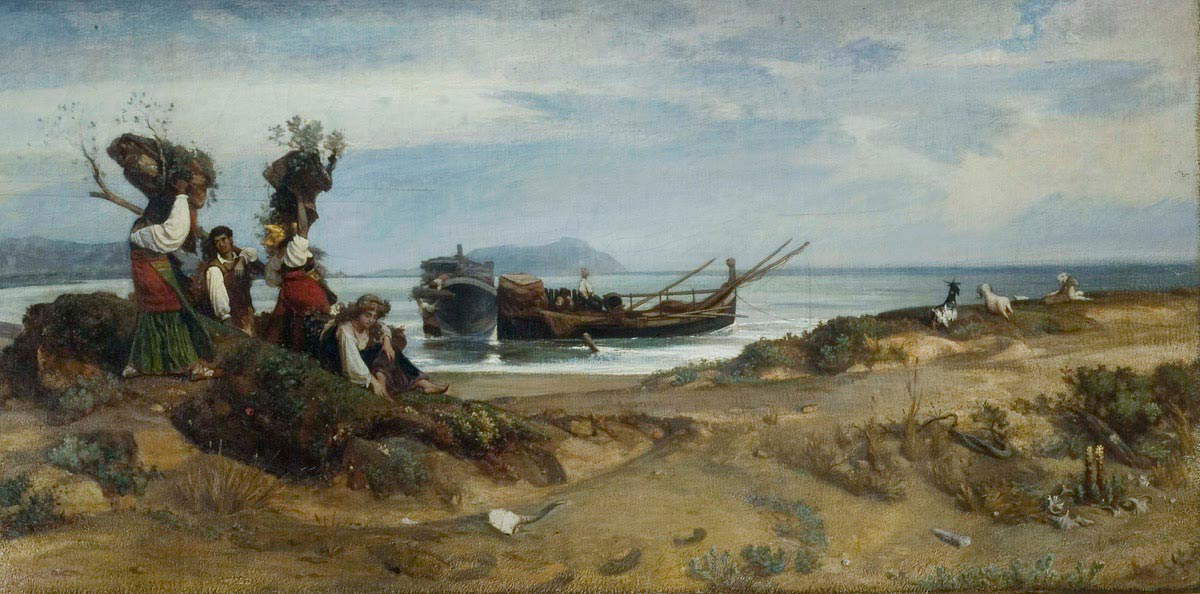Sketch of a masterpiece by Cristiano Banti, pioneer of the Macchiaioli movement, goes up for auction in Rome
One of the preparatory sketches of Boscaiole con fascine, one of the most beautiful paintings by Cristiano Banti (Santa Croce sull’Arno, 1824 - Montemurlo, 1904), a painter of the Macchiaioli group and an early pioneer, along with Signorini and Cabianca, of macchia painting, goes up for auction at the Dams House in Rome, where it is among the lots in the auction Art and Design of the 19th and 20th Centuries, scheduled for Wednesday, Oct. 18, at 3 p.m. At auction it is passed off as attributed to Cristiano Banti, but Dams believes it may be one of the studies Banti made in preparation for his masterpiece, which is now in the Galleria d’Arte Moderna di Palazzo Pitti in Florence. The sketch has an estimate of 8-10,000 euros and an auction base of 3,000.
Datable to a period between 1881 and 1889, Boscaiole con fascine has been identified by critics with a painting mentioned in 1884 by another great artist of the time, Adriano Cecioni, who referred to a painting Banti had been working on for three years. The description of the subject made it possible to identify it with a good margin of certainty: Cecioni had referred to the work with the title Le predone, because these woodcutters, portrayed in the countryside of Tuscany, used to roam the fields and woods not only in search of wood, but of whatever they found and considered useful. "Le predone,“ Cecioni wrote, ”is the title of a painting on which Banti has been working for about three years. The marauders or faci danni are those women who prey on the countryside, attaching themselves to anything, to wood, grain, grapes, olives, chickens, turkeys, ducks and lambs, to spades, hoes, rakes, and finally to everything that comes under their hands. They are thieves who squander, cut down and ravage to pave their way through the thickets, hedges and woods; they go to steal with carts and fight sometimes, to defend the prey they have made. They are strange, fantastic figures, clothed in patches of a thousand colors for the constant tears they bring back in their escapes among the hedges and among the woods; they walk suspiciously, turning their heads back every little bit to see if they are discovered."

According to the scholar Giuliano Matteucci, however, Banti would have started working on the painting as early as 1878, shortly before his stay in London in the following year. It should come as no surprise, however, that it took Banti so long to complete the work: “The slow and thoughtful elaboration necessary for him to craft a work, and at the same time the intellectual curiosity that never failed him,” wrote scholar Silvestra Bietoletti, “induced him to work with the help of photography: a medium he appreciated so much that he himself made the plates by posing his peasant women as well as his daughter Alaide.” Banti is also known to have been one of the first artists to make use of photography, and he used to try different poses until he found the satisfactory one, and he often returned to his works. Cecioni, too, confirms the artist’s great meticulousness in the continuation of his account: “The workmanship is against its usual stormy, because so required by the species of the subject; its incontentiveness is the cause of continual changes that delay the completion of this most interesting work.”
The painting depicts three peasant women hunched under their heavy load of bundles of wood, as they gait briskly against the backdrop of the Tuscan countryside: the outline of the Apennines can be recognized in the distance, and on the left a village clinging to a hill can also be seen. In the background can also be seen a fourth figure pushing a cart, also full of wood. The sky is dotted with white and gray clouds, executed with a vivid sense of atmospheric effects despite their sketchy appearance.


The work dates from the period when Cristiano Banti was frequenting one of Italy’s most modern landscape painters, Nino Costa: Banti’s Boscaiole con fascine , in terms of its subject matter (women doing heavy work in a natural landscape), the way it is approached, and its horizontal format, harks back to one of Costa’s masterpieces, the Donne che imbarcano legna nel porto di Anzio, the first modern landscape in Italian painting, a work from 1852 preserved at the National Gallery of Modern and Contemporary Art in Rome. Banti, however, also gathers other suggestions in his painting, particularly his interest in 15th-century painting: the work, Chiara Ulivi has written, “recalls in solemnity the fifteenth-century predellas, such as that of the Legato Banti Ghiglia in the Gallery of Modern Art,” moreover, “the paused composition, the figures silhouetted neatly against the background, the simplicity and dryness of fifteenth-century scenes also return in some of Lega’s masterpieces.”
The sketch going up for auction at Dams, very close to the final draft of the work and smaller in size, bears on the back the inscription “I give to Cav. Augusto Jandolo this sketch by my grandfather (C. Banti). L. M. Banti. Sketch for the painting Le Fascinanti”: the signature is that of Leon Marcello Banti, grandson of Cristiano Banti, born in 1880, whose statements are always considered very reliable by critics as they are spread by drawing on the family’s historical memory. The dedicatee, Augusto Jandolo, born in Rome in 1873, after a youthful experience as an actor in the company of Eleonora Duse, devoted himself professionally to antiques. He was a member of the “Gruppo dei Romanisti” along with, among others, Trilussa, Cesare Pascarella, Ettore Petrolini, Ceccarius and, from 1933, hosted its monthly meetings in his studio in Palazzetto Patrizi on Via Margutta. Some of his writings appeared in the Strenna dei Romanisti, of which Jandolo was editor from the first issue in 1940.
Several sketches on panel from the collection of Alfredo Banti, the artist’s son, and preserved at the Gallery of Modern Art in Palazzo Pitti, are, however, to be referred to the Boscaiole con fascine.
 |
| Sketch of a masterpiece by Cristiano Banti, pioneer of the Macchiaioli movement, goes up for auction in Rome |
Warning: the translation into English of the original Italian article was created using automatic tools. We undertake to review all articles, but we do not guarantee the total absence of inaccuracies in the translation due to the program. You can find the original by clicking on the ITA button. If you find any mistake,please contact us.




























